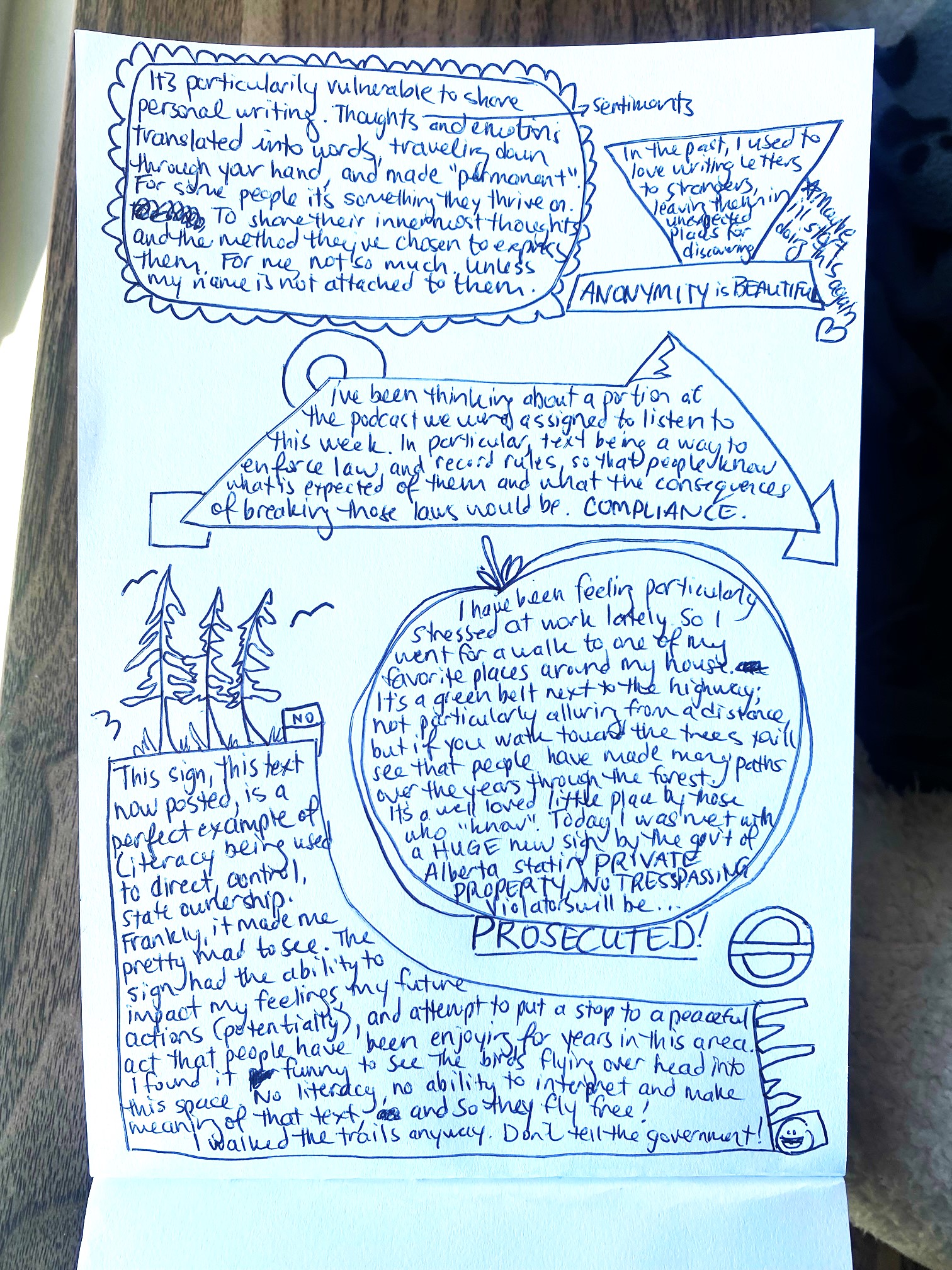Here’s a photo of my manual script, and a few photos of the spaces I’ve referred to in the passage:




Manual Script Reflection:
This assignment was natural for me; I often write in my journal by hand. It’s been something in my life that’s become cathartic. I use it as a way to express myself; not limited by lines on a page, where I can make illustrations in the margins, write non-linearly and get thoughts out of my head. I have volumes of these codices dating back to highschool. These thoughts and entries are rarely (if ever) shared with anybody, and are meant for my own processing—a safe place to reflect.
As mentioned by Lamb & McCormick (2020), text recorded in a codex has the affordance of being able to refer back to concepts made external. By fixing points of information on a page (or parchment, scroll, clay tablet), we create more space in our minds because we are relieved of the need to ‘remember’. We also create something that can be referred to by others, and promotes further inquiry and reflection through space and time. Although I generally don’t share my journal entries with others, I do appreciate the ability to look back at my reflections from different ‘snapshots’ in my life to see how things have changed.
One can see the remnants of handwriting (or cursive) in my printing. This blend between both printing and handwriting serves as a ‘personalized font’, and is not readily replicated in word processing applications, or even in letterpress technologies. It could be argued that a human element is lost when we use technologies to replace writing by hand. This is also seen in how errors/mistakes are addressed. I simply scribbled out a few words that I wanted to change, but in using computer mediated word processors, these changes would be indecipherable and simply ‘deleted’. For the most part I don’t edit my personal journal entries, though. I think there is value in stream-of-consciousness style writing, especially when the intent is expression/reflection.
I write with water-insoluble pen now, at least for text journal entries, because there have been far too many times that I’ve spilled water in my bag and I’ve lost entries. Computer mediated print (especially from an inkjet printer) is susceptible to this same weakness. An affordance that computer mediated writing has over manual methods of writing is that it can be reproduced easily and saved in many places, which decreases the risk of elemental damage. Lamb & McCormick (2020) mention how books have been burned to destroy their lineage and evidence of their existence, but as soon as a text is published on the web, it’s almost impossible to get rid of it completely.
Often in my journal entries, I like to illustrate between thoughts, or contain thoughts in particular shapes. My writing is often not linear, and instead the page becomes a free play of space that I can follow my emotions, thoughts and instincts. Mechanized forms of writing can allow for this to a point (by using a Wacom tablet and digital stylus). However, more formal word processing applications like Microsoft Word or Google docs do not have these affordances readily available.
Lamb, R., & McCormick, J. (Hosts). (2020, May 26). From the vault: Invention of the book, part 1. [Audio podcast episode]. In Stuff to blow your mind. iHeart Radio.
Lamb, R., & McCormick, J. (Hosts). (2020, May 28). From the vault: Invention of the book, part 2. [Audio podcast episode]. In Stuff to blow your mind. iHeart Radio.
Hi Lachelle,
The first thing I noticed (even before reading your reflection) was that I used a lined notebook for this task, whereas you used a blank piece of paper. My response is boring and structured as I wrote in neat, straight lines, left to right, and top to bottom. While I could have added illustrations or ignored the light-coloured lines and wrote diagonally, I didn’t even consider this, allowing the type of paper to impact the structure of my words. It’s also kind of funny to think about the entire paper industry that has emerged…offering blank paper, lined paper, graphing paper, dot paper, columnar paper, etc. There is some practicality behind these options but it also seems a bit unnecessary. If I wanted to sketch something, I could easily do this in my lined notebook, but I would probably opt to buy use a blank-paper notebook instead…consumerism in action!
You mention writing non-linearly and this relates to Task 5 (Twine task) that I just completed. It felt liberating to add thoughts as they came, not in any kind of hierarchical order or structured way. Your blank piece of paper for journaling allows for jotting down thoughts in this non-linear way, as they pop into our minds. You mention that you like to contain thoughts in particular shapes; why is this? And which comes first, the shape outline or the text?
You raise two really interesting points about literacy (in your hand-written journal entry itself) and the human element associated with non-mechanized writing.
It’s funny to think of those birds – illiterate when it comes to human’s English language. This doesn’t mean they can’t communicate, but they can’t in the way that we can. This also makes me ponder about humans who are illiterate in certain environments (e.g. when a human travels to a foreign country, where all signs and oral language are in a different language). Signage depicting rules still apply to them, despite being illiterate in that particular language! Tools such as Google translate have been developed and can help reduce barriers in these types of situations.
Your point about us all having a ‘personalized font’ is very insightful and reminds me of when I mark my students’ hand-written response. I often start to learn whose response is whose, based on their hand-writing and without looking at their name on the first page. I wonder if/when the concept of signatures will become obsolete, particularly as electronic signatures, which sometimes are just names typed in a standard cursive font, are accepted. Without signatures, do we lose a personal identifier or perhaps it was not a strong personal identifier to begin with. What do you think?
Hey Shannon,
You’ve made so many great points in your comment. The whole paper industry in itself has evolved so much over time, and now it certainly has become connected to consumerism. If one wants to get further into a particular creative style, like dot journaling or watercolour painting, the paper itself lends to the craft. This makes me think about that correlation in technology: if one wants to get better at video editing or digital art, there is a push to purchase tools like Camtasia or a Wacom Tablet in order to practice. Although freemium tools work, there becomes a divide between those that have these tools and those who do not. I suppose this links back to literacy being reserved for elite folk, especially historically.
I definitely see the connection between this task and the Twine task; as you pointed out, the Twine story leverages non-linear paths for both the author and the viewer. In theory, no two people would have the same experience going through the task, and the creation process itself is very individual.
You asked about my containing thoughts in shapes, and I’d say that I alternate between putting shapes down first and filling them and writing then containing the text in shapes. I think this has to do partially with creating a visual landscape for my writing. It also creates literal space between thoughts, and when looking back on previous entries, it helps me to remember the thoughts and feelings I was experiencing when writing it. I have done this for a long time, and honestly have never thought much about why 😀 Thanks for prompting me to put it into words!
You raise a great point about signatures and personal fonts. We seem to slowly be moving away from that very personalized non-mechanized way of ‘notarizing’ something, to a technologically mediated one. I think signatures and the way we write can tell a story about ourselves. They become almost a ‘personalized stamp’ that can be hard to reproduce, but with PDF signatures, it becomes more possible to reproduce quickly, and potentially by unauthorized parties. Personally I’m a little old school, and I love learning about why people sign their names in particular ways. Anytime I’ve asked someone, there’s a good story behind how and why they developed that particular signature. Maybe with digital signatures, we lose out on those stories in exchange for technological efficiency. Do you have a story about how your signature came to be?
Thanks again for your comment!